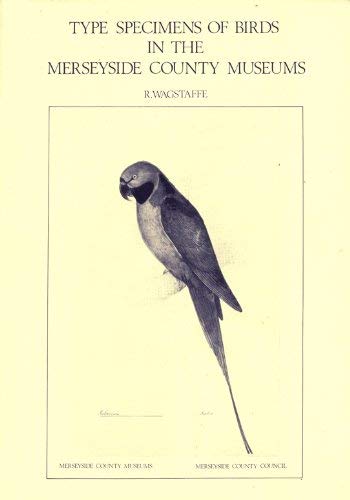What’s a type? A guide to type specimens
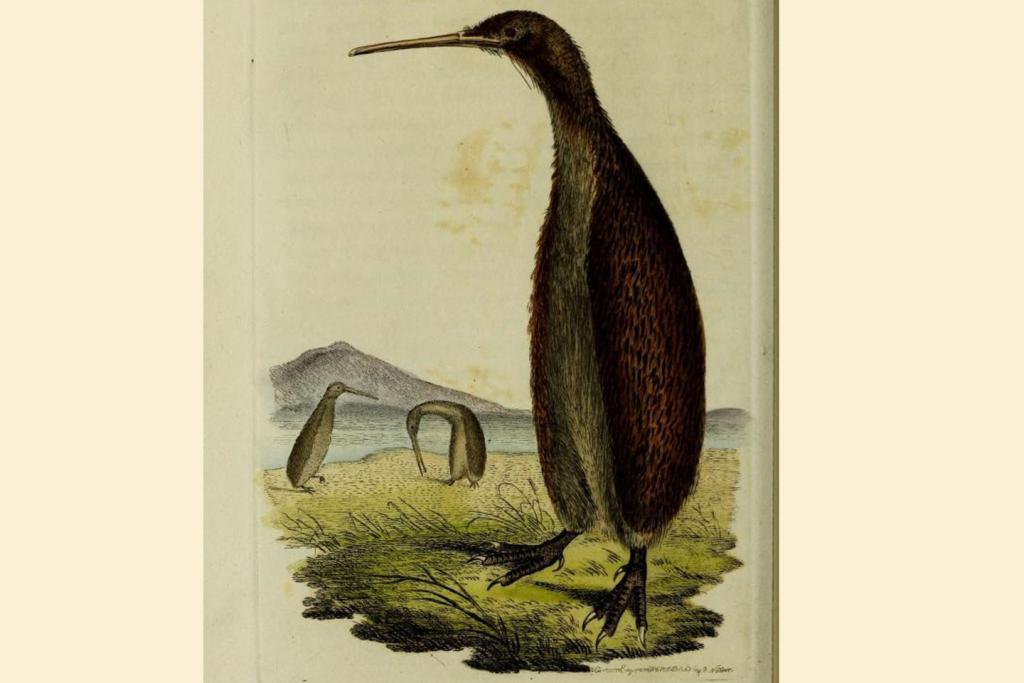
Lead image: A drawing of the type specimen of the Southern Brown Kiwi (Apteryx australis Shaw, 1813) held at World Museum (with accession number LIV D180). Available from the Biodiversity Heritage Library.
When natural history curators get together we love talking about our types. This is because “type” means something quite different to working biologists than it does to Love Island contestants. When curators talk about our “types” we’re talking about type specimens. Type specimens have a vital role in the science of taxonomy and this means they are among the most scientifically-valuable and historically-significant specimens in the collections we care for.
Taxonomy is simply the practise of organising things into categories to make our lives easier. It’s part of human nature. For example, you might organise your wardrobe into t-shirts on the left, shirts on the right and long-sleeved t-shirts in the middle (or maybe that’s just me). To be most useful, taxonomy relies on a universally agreed vocabulary. For example, when shopping online at UNIQLO you can search for “t-shirt”, if that’s what you’re after, rather than having to browse through every item in the store.
Taxonomy as a science applied to living organisms is said to have begun with Aristotle (384-322 B.C.E.), the Ancient Greek philosopher. Aristotle proposed what is known as the “Scala Naturae” (the ladder of nature) which organises living organisms along a scale of perceived complexity, with humans at the top. The Aristotelian system served Europeans well until the growth of scientific thought during the Renaissance, and the exploitation of the natural world during globalisation, demanded a more comprehensive taxonomic system.
Consequently, modern taxonomy is said to have begun with Swedish botanist Carl Linnaeus (1707-1778 C.E.). Building upon work by his forerunners, in the epic, “Systema Naturae”, Linnaeus made the first ever serious attempt to catalogue all of our planet’s species. This work was trailblazing because it consistently applied a “binomial” system for scientifically naming species, setting the standard still used today.
In the Linnaean tradition, a scientific species name has two parts1, a genus name which comes first and is capitalised, and a specific name (or species epithet) which is all in lower case2. The names must be in Latin, Greek, or Latinised language and when typed should be italicised, or if handwritten the names should be underlined. This is why scientific species names are colloquially called “Latin names”. Note that a genus can include several species, so species can share the same first name, but the combination (genus + specific name) must be unique. Species names are often written together with the name of the scientist (the “author”) who came up with the name and first used it in print - an action known as “describing the species”. This is sometimes followed by the year that this happened. Linnaeus is such a special person in the history of taxonomy that his name is often simplified to just “L.” (or “Linn.”).
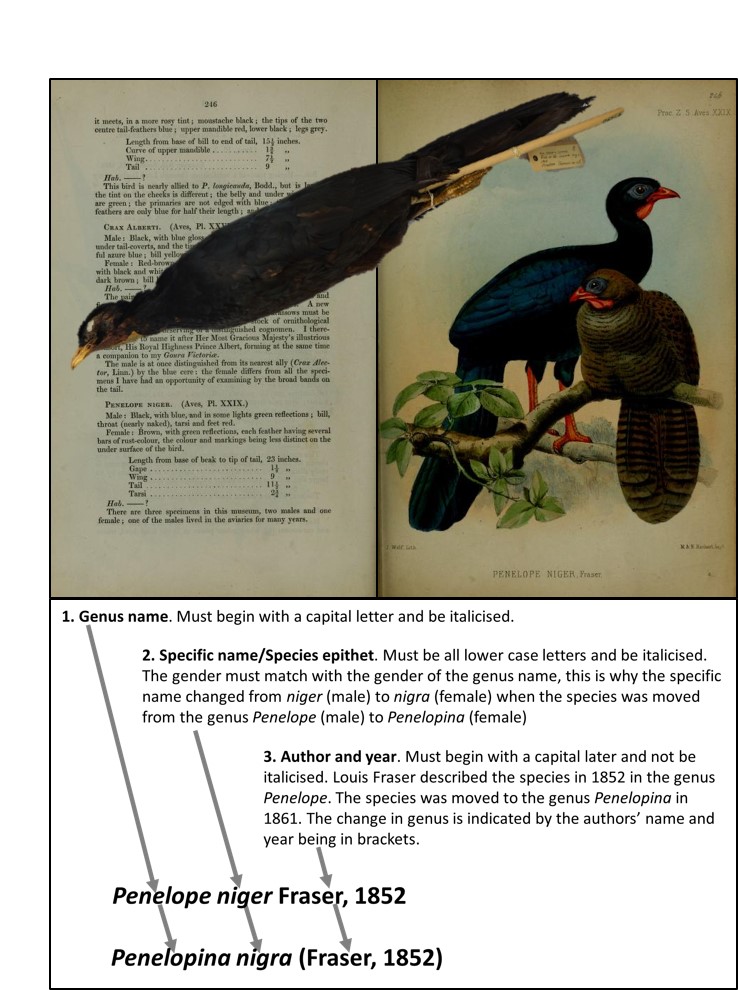
The original description of Penelope niger Fraser, 1852 available from the Biodiversity Heritage Library, the male syntype at World Museum (accession number LIV D484), and a guide to writing scientific species names.
What emerged over the next century were a set of rules for taxonomy culminating (for animals) in the official “International Code of Zoological Nomenclature” first published in 1905. The Code has been revised and improved over the years but the guiding principles remain. Only names published in, or after, the 10th edition of Linnaeus’ “Systema Naturae” (officially dated 1758-01-01) are considered valid. If a species has been described multiple times and been given several names, the oldest name is given priority and is considered the only valid (correct) name for that species.
The Code also formalised the principle of “typification”. This is the principle that each described species has, actually or potentially, a name-bearing type specimen. Essentially the name used in the description belongs to the type specimen. The principle of typification cannot answer the question of whether two specimens are the same species or not. That’s a judgement that still has to be made by a taxonomist. But having “name-bearing” type specimens provides for certainty in the use of names. If you judge that an unknown specimen is indeed the same species as a name-bearing type specimen, then you know with certainty the correct name to apply to the unknown specimen – the name belonging to the type.
The Code recognises several different kinds of type specimens, divided into primary types with name-bearing status, and secondary types with no name-bearing status.
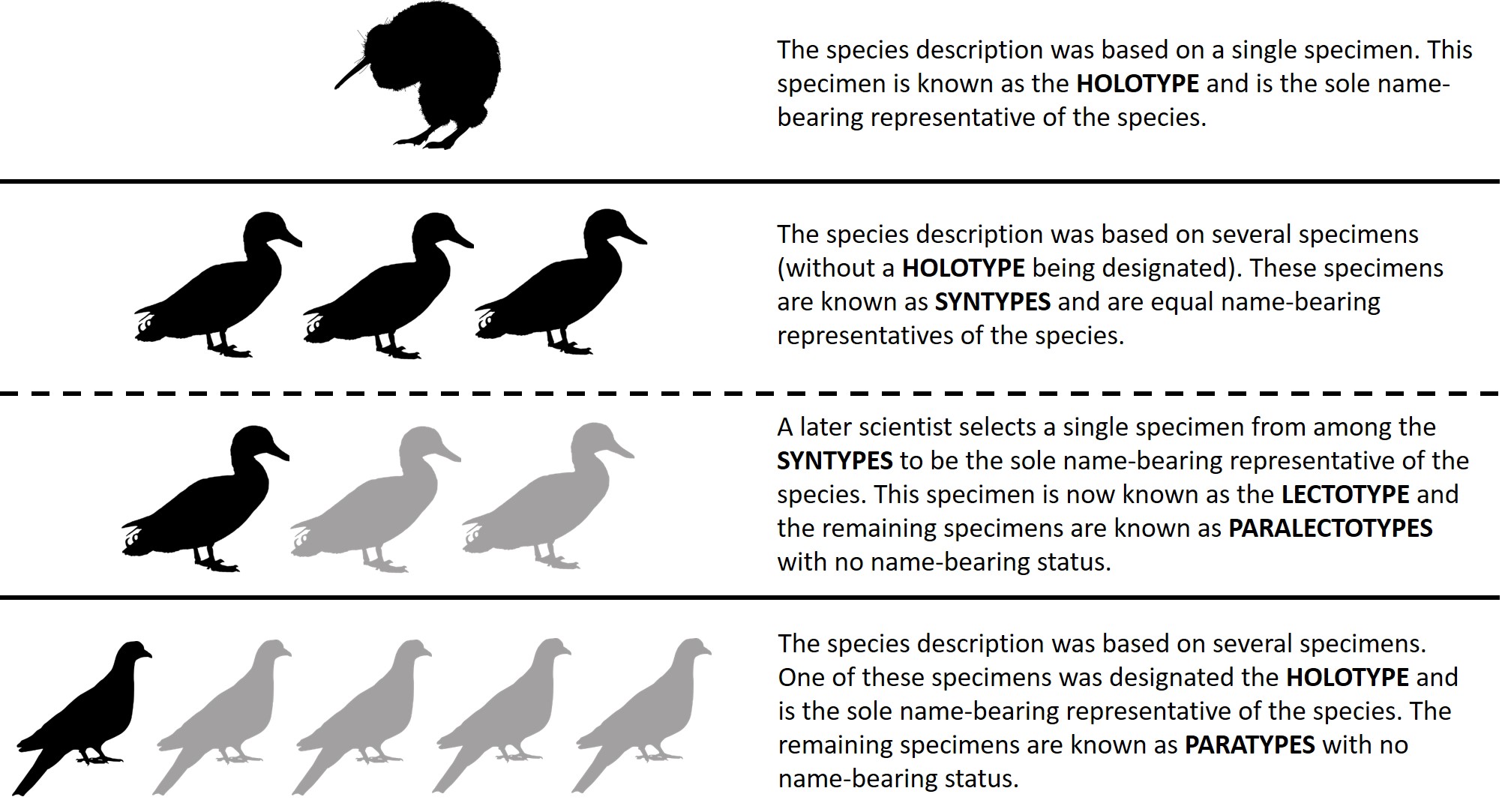
A guide to the different kinds of type specimens including primary types (black) and secondary types (grey).
A fundamental challenge for natural history curators, including all my predecessors and I, is tracing these types. This requires careful historical detective work to find the specimens that an author would have had access to when they were writing their species descriptions. Different lines of evidence can be used to make the case that a specimen is a type: the specimen’s journey through various collections (its provenance); information on specimen labels; information in collectors’ and museum catalogues; agreement with measurements given in species descriptions; and similarities to drawings and paintings of the type specimen. According to a recommendation in the Code, it should be assumed that scientific species names all have syntypes rather than a holotype. Given the “prestige” of having types in collections, competing claims for possessing name-bearing types can arise.
Obviously the majority of routine species identifications cannot be made through direct comparison with type specimens. In practice, type specimens are the first link in a network of chains whereby specimens in other museums may have been checked against the types, then these specimens are used to help identify other specimens, which may then be used as the basis for identification keys, field guides, and so on. Diagnostic characters such as DNA barcodes can strengthen the chains. When there are small kinks in a chain it may be necessary to refer back to the types and we regularly get email requests for photographs of types held at World Museum. For more substantial kinks it could be necessary for the taxonomists to visit the types in person during a research visit, and maybe even take DNA samples (as has been the case with the Southern Brown Kiwi Apteryx australis Shaw, 1813).
The collection of birds at World Museum is one of the most important in the world and includes a large number of types. My predecessor, Reg Wagstaffe, made a monumental effort to trace types and, greatly assisted by Peter Morgan and Clem Fisher, published a catalogue of type specimens in 1978 after he had retired. Wagstaffe’s catalogue lists 318 primary type specimens for 222 scientific names. There are thought to be a roughly equal number of types in the collection which were not included in Wagstaffe’s catalogue, uncovered by my more recent predecessors, Malcolm Largen and Clem Fisher, among others. For example, during recent work by volunteers photographing specimens from the Liverpool and British Museums joint expedition to Socotra in 1898-9, it became clear that a specimen of Phalacrocorax nigrogularis Ogilvie-Grant & Forbes, 1899 (with accession number LIV [19]31.12.00.185) held at World Museum is a syntype. Henry Ogg Forbes was Director of the Liverpool Museums, although he still had time for some ornithology.
The type catalogue published by Wagstaffe (1978). On the cover is a black-and-white copy of Edward Lear’s original painting of the type specimen of Psittacula derbyana (with accession number LIV D798), named from a single specimen (the holotype) by Derby’s curator Louis Fraser in 1850. Lear’s painting is kept in the Library at Knowsley Hall, home of the Earls of Derby.
After the Leverian Museum was closed the collections were sold off and Lord Stanley (the future XIIIth Earl of Derby) bought the type specimen at auction in 1806. With Stanley’s death in 1851, his collection passed to the people of Liverpool and founded what was to become National Museums Liverpool. The specimen is currently known as Glycifohia undulata (Sparrman, 1787) due to an earlier description of the same species by Sparrman. However, Sparrman’s type specimen is believed to have been destroyed before 1805. Interestingly, Stanley’s specimen is also probably the type of Certhia fasciata Forster, 1844 (yes, this can happen!).
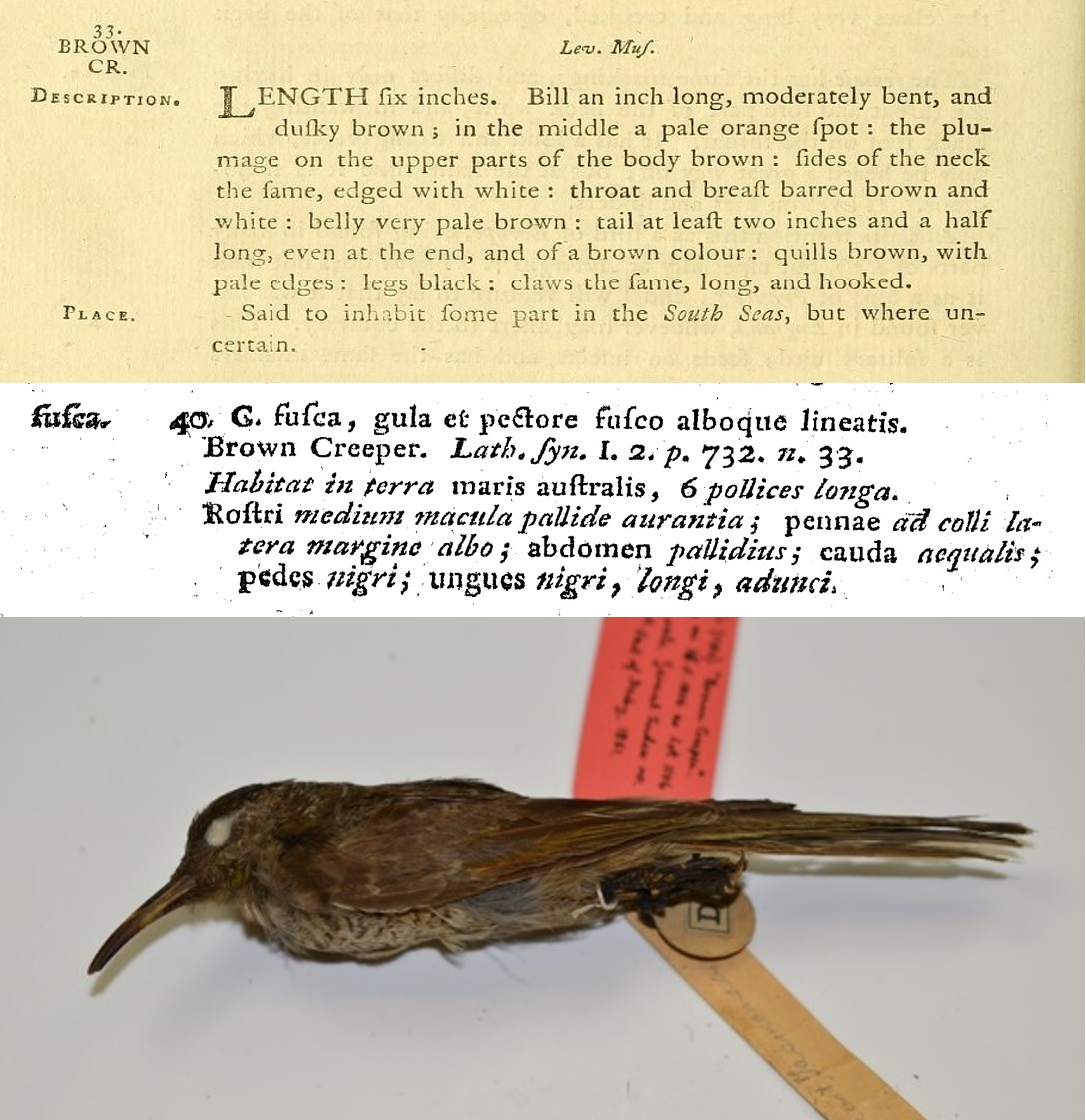
The original, but invalid description of the Brown Creeper by Latham (top), the scientific species description of Certhia fusca Gmelin, 1788 (middle) and the type specimen (with accession number LIV D5322) at World Museum, collected during the second voyage of Captain Cook (bottom).
1Trinomens – three-part names - are also commonly used, particularly for birds. This system follows the same conventions as the binomial names but an additional subspecies name is included as the final name. For example, Spilornis cheela rutherfordi Swinhoe, 1870, of which the syntype from Hainan is held at World Museum (with accession number LIV T.2819). Note, Robert Swinhoe is the author of “rutherfordi” not “cheela”.
2When specific names derive from proper nouns (names of people or places), the original authors sometimes capitalised these names. For example, Oreophasis Derbianus Gray, 1844, of which the holotype from Guatemala is held at World Museum (with accession number LIV D210), was named after the XIIIth Earl of Derby. However, this is now written in the modern style, where specific names are all in lower case - Oreophasis derbianus Gray, 1844.

